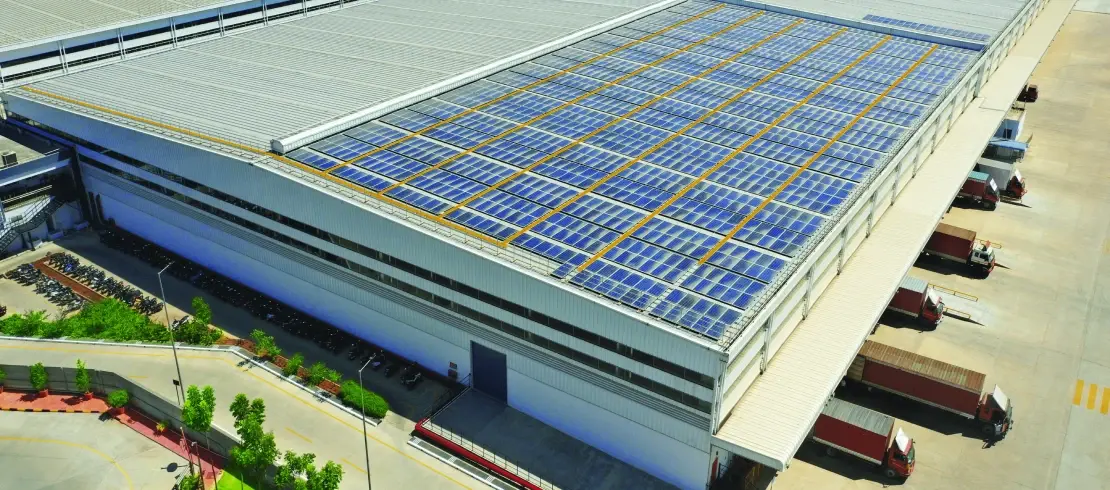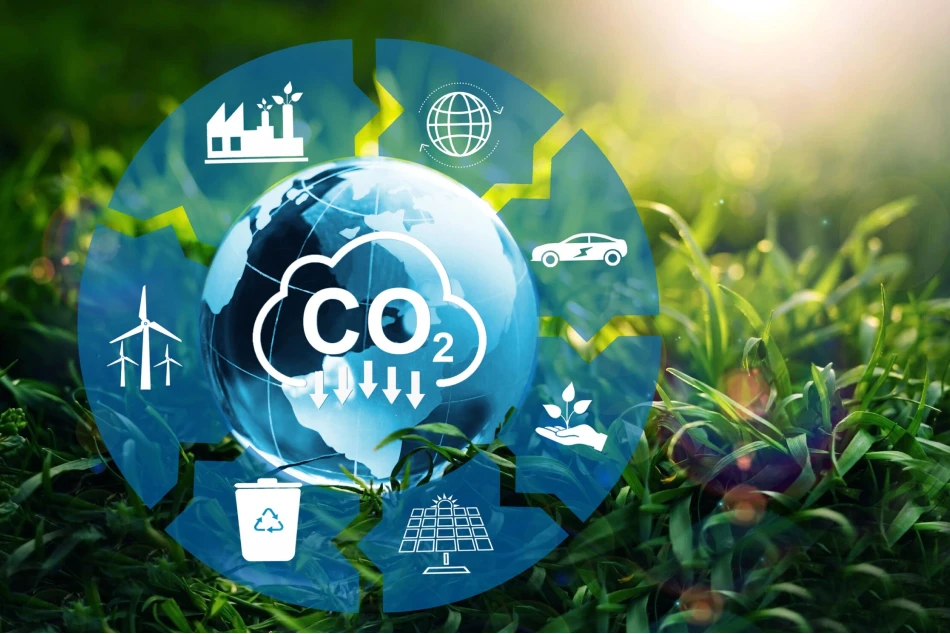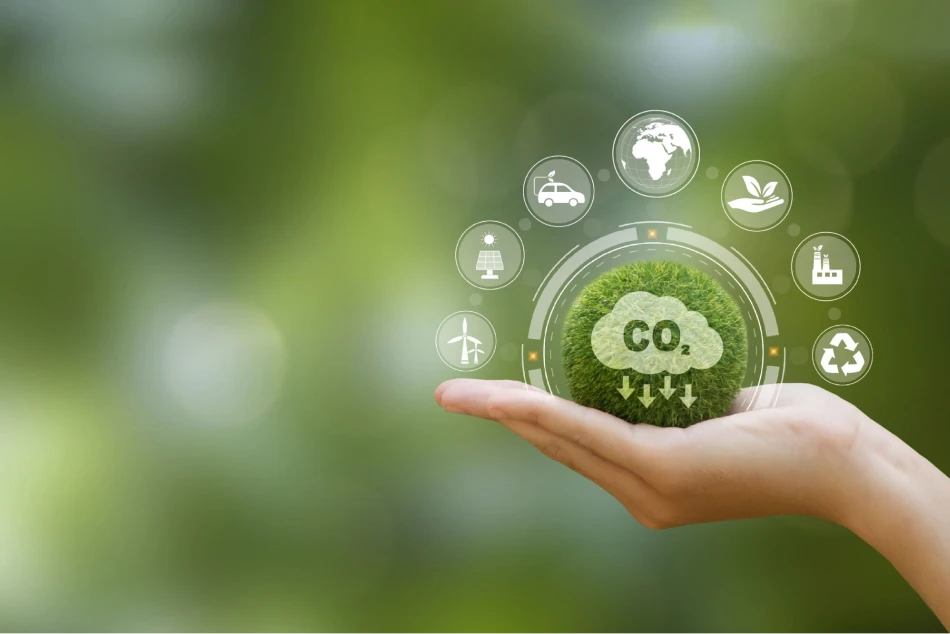Carbon Commitment: A Net-Zero Sum Game

India’s IRE (Industrial Real Estate) sector, which has grown at a fast clip since the introduction of GST, continues to play a significant role in promoting and implementing sustainability practices in the industrial sector. But more needs to be done.
Lately, if the Indian summer feels hotter to you than before, it is not a sign of you getting older; it is a sign that you are right about this. The average temperature in India has risen by 0.7 degrees Celsius (33.2 degrees Fahrenheit) in the past century, said a recent Indian Institute of Tropical Meteorology study1. The study also found that the number of heatwaves in India has doubled since 1961.
This steady rise in temperatures in the country is part of a worldwide phenomenon called global warming. The United Nations’ Intergovernmental Panel on Climate Change (IPCC) defines global warming as an increase in combined surface air and sea surface temperatures averaged over the globe and 30 years2. Global warming is just one effect of mankind-induced changes in the climate. Other significant developments include an increase in the precipitation of moisture in the air, which leads to heavier rains and snowstorms, and increased variability in wind patterns that causes extreme weather events like hurricanes and wildfires to be more likely and frequent.

Collectively, these factors have created what we know as the Climate Change crisis, which has become the number one challenge that the world is fighting together today.
India has taken a proactive role in the global quest to combat climate change. A primary aim in this quest is to achieve the Paris Agreement target of holding the global average temperature to well below 2 degrees above pre-industrial levels3.
At the COP27 UN Climate Change Conference held in mid-November 2022 in Sharm el-Sheikh, Egypt4, India presented its commitment to this aim through its Long-Term Low Emissions Development Strategy (LT LEDS), joining a select group of countries to have done so.
India’s LT LEDS strategy and measures, like increased use of renewable energy sources and enhanced forest and tree cover, outlined a significant role for the country’s industrial sector. It envisaged an increase in energy efficiency in the industry through measures such as
Perform, Achieve and Trade (PAT) scheme, the National Hydrogen Mission, utilization of a high level of electrification in all relevant processes and activities, and enhancement of material efficiency and recycling leading to the expansion of the circular economy5.
India’s Industries: Partners in the Arena
India’s climate-action strategy rightly places a significant emphasis on the country’s industrial sector. Emissions and effluents originating from industrial activity are among the most important sources of environmental pollution6. India’s government ministries and departments continually deploy measures to combat pollution caused by industrial action. Some recent examples of such measures include the notification and monitoring of emission and effluent standards under the Environment (Protection) Act7, making regular Environment Auditing for industries mandatory, and promoting cleaner technologies and renewables for energy generation and conservation.
The country’s industrial sector has been doing its part by implementing various innovative technologies and strategies to improve environmental sustainability. A prominent example of this is Science Based Targets initiative (SBTi)8 – created through a partnership between CDP (Carbon Disclosure Project), the United Nations Global Compact, World Resources Institute (WRI), and the Worldwide Fund for Nature (WWF) – is a global campaign managed by organizations based in significant economies. SBTi defines and promotes best practices in emission reductions and net-zero targets in line with climate action goals. According to a recent ANI report, India’s companies have agreed. As of July 2022, 92 large Indian companies had committed to SBTi and 41 companies, including top industrial sectors companies like Galaxy Surfactants, Mahindra and Mahindra, and Hindustan Zinc Limited (HZL), and had their targets approved by the network9. For context, SBTi presently has over 2,000 organizations worldwide as partners committed to emission targets set by the SBTi.
Indian industrial firms have also significantly participated in the global carbon credits trade. The trade of carbon, which the Kyoto Protocol made a tradeable good in 1997, incentivizes companies and economies worldwide to invest more in environmentally friendly and sustainable activities such as reforestation and water conservation practices. Between 2010 to 2020, Indian organizations, including industrial sector companies, issued nearly 17 percent of all carbon market credits given globally, as per a recent Deccan Herald report10. To harness such activities for India’s net-zero 2070 commitment, the government recently introduced the Energy Conservation (Amendment) Bill, passed by the Parliament in December, which gave a legislative push to India’s domestic carbon credits market11. In addition, the Bill has introduced several measures for the industrial sector, including its real-estate segment, that promise to revolutionize the sector’s contribution to climate action.

India’s IRE Sector: Shoulder to the Wheel
Investors define Industrial real estate (IRE) as a type of commercial asset class utilized for industrial purposes like production, manufacturing, assembly, warehousing, data storage, and distribution of goods and products. IRE properties are typically characterized by their large size, high ceilings, heavy-duty construction, and easy access to logistics infrastructure, such as highways, airports, and seaports.
IRE is a fast-growing industrial vertical in India, which gained momentum mainly following the introduction of GST in July 2017. The new single, nationwide tax made it easier for companies to move goods across state borders, which led to the consolidation of warehouses as companies no longer needed to maintain multiple warehouses in different states to comply with tax laws. This helped the country’s IRE sector grow at a fast clip. A recent Mint news article quoting a Savills India report noted that the country’s industrial and warehousing sector recorded a strong absorption of nearly 11 million square feet in Q1 of 2023, with tier-I cities driving 77 percent of the demand12. And it is set to grow faster at a CAGR of 15 percent over the next five years, driven by e-commerce and the manufacturing sector growth, according to property consultants Knight Frank India. The top six cities for IRE development in India are Mumbai, Delhi-NCR, Bengaluru, Chennai, Pune, and Hyderabad.
IRE’s pivotal role in the industrial sector puts on it a great deal of responsibility to do its part in helping the economy meet its sustainability commitment. The industry does it through several sustainability practices, such as designing energy-efficient buildings and adhering to global standards and procedures.
Eyes on the Prize
Ensuring environmental sustainability, particularly in the industrial sector, is a high-stakes endeavor. There are numerous challenges to tackle, and our collective future and the earth’s future is at stake. This task’s biggest challenge is the lack of awareness and understanding among stakeholders, including businesses, investors, owners, and developers, about the importance of environmental sustainability. Most of the stakeholders still prioritize cost and quick construction over sustainable practices. This is also a big reason why IRE incumbents like Horizon Industrial Parks and others are sharply focusing on meeting the net-zero carbon commitment made to humanity.
Citations
- https://www.newindianexpress.com/nation/2020/jun/15/temperature-over-india-likely-to-rise-by-44-degrees-celsius-by-end-of-21st-century-says-govt-repor-2156889.html
- https://www.ipcc.ch/sr15/chapter/chapter-1
- https://unfccc.int/process-and-meetings/the-paris-agreement
- https://www.india-briefing.com/news/india-cop27-long-term-low-emission-development-strategy-submitted-unfccc-26430.html
- https://pib.gov.in/PressReleasePage.aspx?PRID=1875816
- https://ig.ft.com/india-pollution
- https://moef.gov.in/en/service/environment/pollution
- https://sciencebasedtargets.org/about-us
- https://www.aninews.in/news/business/business/national-carbon-market-indias-roadmap-to-climate-action-and-transition-to-net-zero20220818133345
- https://www.deccanherald.com/science-and-environment/carbon-credits-and-india-s-carbon-market-1163828.html
- https://economictimes.indiatimes.com/industry/renewables/energy-conservation-bill-2022-implications-and-next-steps/articleshow/96562493.cms?from=mdr
- India’s IWS sector soars: Report | Mint